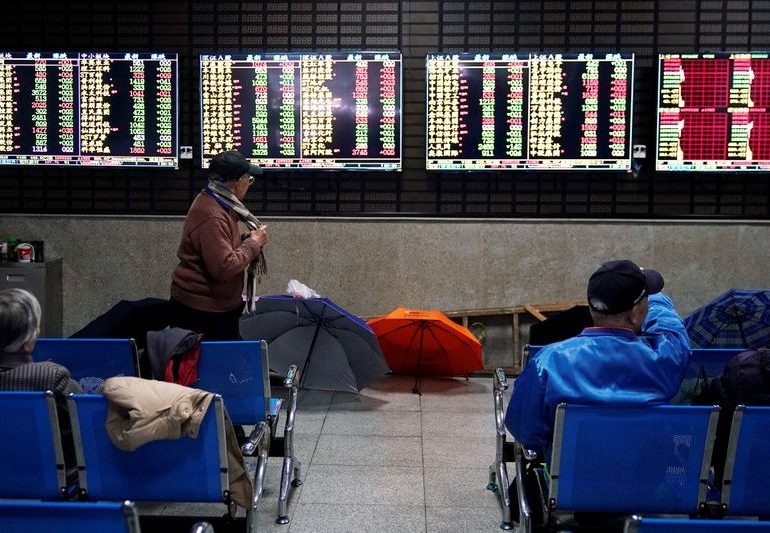2/2  © Reuters. Investors look at screens showing stock information at a brokerage house in Shanghai 2/2
© Reuters. Investors look at screens showing stock information at a brokerage house in Shanghai 2/2
By Wayne Cole
SYDNEY (Reuters) – World shares paused to assess a record-busting month on Monday as the prospect of a vaccine-driven economic recovery next year and yet more free money from central banks eclipsed immediate concerns about the coronavirus pandemic.
Helping sentiment was a survey showing factory activity in China handily beat forecasts in November, and the country's central bank surprised with a helping of cheap loans. That left blue chips up 1.3% on the day and 7.4% for the month.
The rush to risk has also benefited oil and industrial commodities while undermining the safe-haven dollar and gold.
"November looks set to be an awesome month for equity investors with Europe leading the charge at a country/regional level," said NAB analyst Rodrigo Catril.
Many European bourses are boasting their best month ever with France up 21% and Italy almost 26%. The MSCI measure of world stocks is up 13% for November so far, while the S&P 500 has climbed 11% to all-time peaks.
Early Monday, MSCI's broadest index of Asia-Pacific shares outside Japan slipped 0.4%, to be up almost 11% for the month in its best performance since late 2011.
Japan's Nikkei 225 eased 0.4%, but was still 15.4% higher on the month for the largest rise since 1994.
E-Mini futures for the S&P 500 dipped 0.4%, and EUROSTOXX 50 futures 0.6%.
"Markets are overbought and at risk of a short term pause," said Shane Oliver, head of investment strategy at AMP (OTC:AMLTF) Capital.
"However, we are now in a seasonally strong time of year and investors are yet to fully discount the potential for a very strong recovery next year in growth and profits as stimulus combines with vaccines."
Cyclical recovery shares including resources, industrials and financials were likely to be relative outperformers, he added.
The surge in stocks has put some competitive pressure on safe-haven bonds but much of that has been cushioned by expectations of more asset buying by central banks.
Sweden's Riksbank surprised last week by expanding its bond purchase program and the European Central Bank is likely to follow in December.
DOLLAR IN DECLINE
Federal Reserve Chair Jerome Powell testifies to Congress on Tuesday amid speculation of further policy action at its next meeting in mid-December.
As a result U.S. 10-year yields are ending the month almost exactly where they started at 0.84%, a solid performance given the exuberance in equities.
The U.S. dollar has not been as lucky.
"The idea that a potential Treasury Secretary (Janet) Yellen and Fed chair Powell could work more closely to shape and coordinate super easy monetary policy and massive fiscal stimulus that could drive a rapid post pandemic recovery saw the dollar under pressure," said Robert Rennie, head of financial market strategy at Westpac.
Against a basket of currencies, the dollar index was pinned at 91.771 having shed 2.4% for the month to lows last seen in mid-2018.
The euro has caught a tailwind from the relative outperformance of European stocks and climbed 2.7% for the month so far to reach $1.1967. A break of the September peak at $1.2011 would open the way to a 2018 top at $1.2555.
The dollar has even declined against the Japanese yen, a safe-haven of its own, losing 0.7% in November to reach 103.89 yen, though it remains well above key support at 103.16.
Sterling stood at $1.3334, having climbed steadily this month to its highest since September, as investors wagered a Brexit deal would be brokered even as the deadline for talks loomed ever larger.
One major casualty of the rush to risk has been gold, which was near a five-month trough at $1,771 an ounce having shed 5.6% so far in November.
Oil, in contrast, has benefited from the prospect of a demand revival should the vaccines allow travel and transport to resume next year. [O/R]
Some profit-taking set in early Monday ahead of an OPEC+ meeting to decide whether the producers' group will extend large output cuts. Brent crude futures fell 52 cents to $47.66, while U.S. crude eased 60 cents to $44.93 a barrel.
Leave a comment
